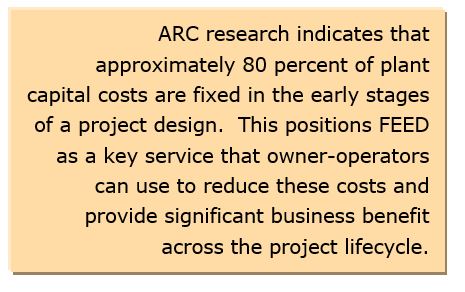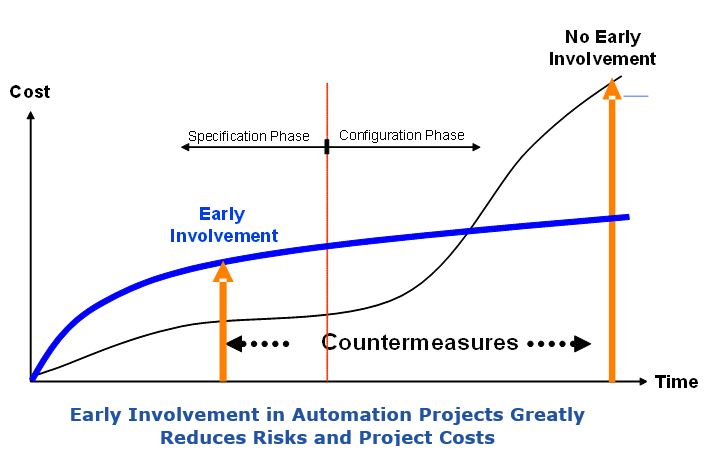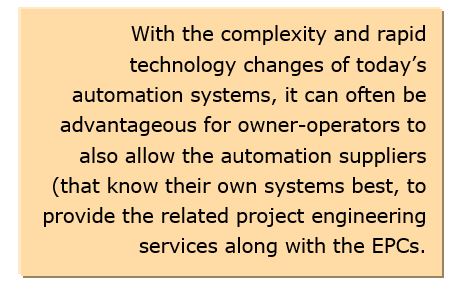

A common theme that emerged at ARC Advisory Group’s recent Industry Forum in Orlando is that capital projects today frequently take too long to execute, cost too much, and involve too much risk, and the question is how to reduce project capital costs . This costs industrial organizations millions of dollars in capital expenditures and lost production, even for relatively short delays. This 
According to many owner-operators and EPC (engineering, procurement, and construction) contractors, automation is often on the “critical path” in these project delays. Incomplete front end engineering design (FEED) issues that can linger throughout the project and much longer operating phases of the plant lifecycle are particularly problematic.
A major part of the problem is that owner-operators and their EPCs alike have an increasingly limited pool of skilled workers, particularly those with in-depth knowledge of the industrial processes and associated automation technologies. This makes it challenging to protect margins and meet continually changing customer demands and market conditions. Faced with dwindling human and capital resources, everyone is being asked to “do more with less.”
In response, a handful of leading automation suppliers have beefed up their own resources and marshalled their technologies and know-how to be able to offer their own FEED services. The objective is to help take automation off the critical path for both capital projects and ongoing operations. This is consistent with ARC’s own research, which indicates that approximately 80 percent of plant capital costs are fixed in the early stages of a project design. This positions FEED as a key service that owner-operators can take advantage of to help reduce these costs and provide significant business benefit across the project lifecycle.
When looking at the total cost of a project, the automation portion of a project tends to be quite small. For an average refinery, for example, automation can represent 1 percent or less of total project spending. Other aspects of the project, such as piping, fittings, and vessels account for much more. For this reason, the value that automation brings to a project is often overlooked. However, automation provides the “brains” behind the plant, and the process cannot run without a well-thought-out and well-executed automation strategy.

Despite the relatively small size of the automation portion of a project, automation is frequently on a critical path and can adversely affect project start up times. Owner-operators are challenged when it comes to managing ever-increasing project costs. Last minute changes and additions frequently extend project cycle times, projects are often behind schedule, and most projects go over budget. At the same time, many owner-operators face mounting pressure to execute projects flawlessly, on time, and on budget; with a path to operational readiness. This means the plant is 100 percent ready for full operation right out of the gate.
One of the first steps to realizing better project success is early involvement by the automation supplier in the overall project cycle. 
Changes made in later phases of the project cost owner-operators far more than those made in the earlier phases. Early involvement means that fewer changes are made during project execution. This is due to a smoother transition between the project’s specification and configuration phases.
FEED is one early involvement example that can have a big impact and add value. The FEED stage is where much of the value is built into the project. Many suppliers view the FEED process, in conjunction with consulting, to be a critical factor in determining project success and derived benefits for the customer. Technologies such as fieldbus, dynamic optimization, and real-time performance management rely on a good engineering and design effort, as well as a seamless transition from engineering and design to implementation, operations, maintenance, and the rest of the plant lifecycle. Suppliers can leverage the knowledge gained through their FEED work to create more effective automation strategies.
With investment capital tight for many companies, any new project must face stringent ROI analysis to gain management approval. Once approved, completing projects on time and within budget is critical to the bottom line. Here, FEED represents a critical component of project activities. For owner-operators to execute projects and lower costs and design risk and maintaining quality expectations, they must have a solution that can accept late changes and apply knowledge rules to templates. They should be given an opportunity to reduce the project schedule by adapting to the maturity of the EPC design information, using incomplete “early/ preliminary” design project data and removing project constraints, such as the traditional full hardware factory acceptance testing (FAT). They must be able to reduce time to value by using cutting edge emulation technologies to ensure that process design, control schemes, and startup procedures are tested dynamically in advance; and engineers, operators and field technicians are fully trained in both startup and plant operations.
Traditionally, owner-operators delegated FEED, detailed engineering design, systems procurement, and final construction to their 
Information management and interoperability of models and data are critical to successfully managing large projects. Owner-operators have made it clear that they need better data management platforms with a more collaborative engineering design environment for their geographically dispersed engineering teams. They see the need to move to a central data repository for all design models, build data, and equipment and asset data. Moreover, beyond engineering organizations, they need a highly collaborative platform to support the wide range of users throughout the global operations typical of today’s companies.
ARC encourages owner-operators to evaluate new technologies, approaches, and work processes as they relate to their projects. ARC believes that, when applied properly, they offer the potential to reduce installed project costs by at least 30 percent and reduce time to value, while yielding significant cost reductions in the much longer operate-and-maintain phase of the plant or other industrial facility.
Companies across nearly every vertical industry must invest to build new assets or revamp existing assets to meet market and/or regulatory demands. In today’s capital-constrained environment, it can be challenging to obtain the metrics needed to justify a project. No owner-operator or EPC can risk having a project run late or go over budget. Reliable and transparent management of the FEED is needed to avoid this. FEED solutions should go a long way toward helping improve engineering efficiencies, reduce costs, increase safety, assure regulatory compliance, quality requirement and shorten project schedules.
If you would like to buy this report or obtain information about how to become a client, please Contact Us
Keywords: Project Execution, Engineering, FLEX, Costs, Risk, Lean, Automation, ARC Advisory Group.

